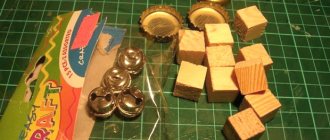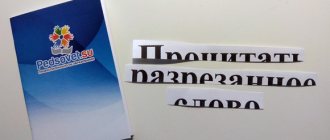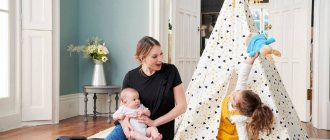March 12, 2019
Averyanova Sveta
Zaitsev's cubes have been discussed and debated for 30 years. Supporters of the method prove its effectiveness, opponents consider reading in warehouses harmful for future schoolchildren. Without practical experience in using technology, it is quite difficult to understand who is right. We also decided to participate in the discussion, but first we will understand in detail what the meaning of Zaitsev’s technique is, why it is unique and how to conduct classes with children at home.
Basic principles and essence of the methodology
Zaitsev's cube training method is based on reading by warehouses.
To understand what a warehouse is, put your hand to your chin and say any word. For example, K-RO-VAT. How many times the chin rests on the palm, there are so many meanings in the word. It turned out to be 3 warehouses, but 2 syllables according to the rules of the Russian language.
Nikolai Aleksandrovich Zaitsev believes that reading syllables is much more difficult for children. It’s easy to understand his point of view; try to put together the word VSVE-PE-ZUL-SYA, syllable by syllable. For a first or second grade student this is an impossible task, there are too many consonants. And according to the warehouses, they consist of any number of letters, it’s easy to read: VS-T-RE-PE-NULL-SIA.
The author does not use the alphabet or primer, and does not talk about letters and sounds separately. Children don’t need theory, says Zaitsev. It is necessary to form an image through clear examples and use concrete, visual thinking.
The kids themselves will understand the softness, sonority, and dullness of warehouses. The cubes are filled with pieces of wood and iron, they are different in size and color. Children feel them, evaluate their parameters and sound. The set includes the following cubes:
- Large ones with hard folds, small ones with soft ones.
- Double - combinations of a consonant and a vowel.
- White is for punctuation marks.
Fillers are needed to indicate sound:
- Iron - voiced consonants.
- Golden - vowels.
- Wooden - voiceless consonants.
- Iron and wood are combinations with a solid sign.
- Wood and gold are combinations with a soft sign.
The lines are written in different colors: blue for vowels, blue for consonants, green for hard and soft signs.
Preschoolers form a clear image of the warehouse based on sensations, without relying on a specific letter of the Russian alphabet. Then you need to move on to working with visual and effective thinking: the child sees the warehouses, hears their sounds and acts according to the example. Verbal-logical thinking is formed by writing words with a pointer and by fluent reading.
Thus, Nikolai Zaitsev based his working method on the following principles:
- The child speaks in forms, hears them, which means he must read according to the example of oral speech.
- All senses are used for learning: vision, tactile sensations, hearing. The child touches the cubes, hears the sound of their fillers, sees the written words, and learns the songs.
- First we write, then we read. Homemade copybooks do not develop speed reading skills; they are mechanical work. According to Zaitsev, a child learns to recognize a word with his fingers, showing its parts (warehouses) on a table or cubes.
- Forming fluent reading. This guarantees love for the book, writing without grammatical errors or spelling mistakes.
- The monotonous lesson must be eliminated.
All classes are conducted in a playful way. There is no lesson plan, the child himself regulates the load and type of game. Use ready-made activities and come up with your own options.
This is interesting! Left-handed people learn speed reading using Zaitsev's cubes better and faster. They have a more developed right hemisphere of the brain. That is, intuition, creativity, non-standard and logical thinking are well formed.
Watch a short video about what Zaitsev’s method is and how to teach a child using it.
How do we teach children to read?
Should preschoolers be taught to read? On the one hand, this is quite difficult and impractical, since high-quality mastery of reading skills implies a certain level of development of thinking - at the level of a 6-7 year old healthy child. However, traditional school teaches children to read in a way that is not entirely correct, incomprehensible and difficult for almost all students. And an alternative teaching method will be more effective at an early age.
In our speech, we do not pronounce individual sounds - we speak in words that consist of syllables. But it would be more correct to operate not with syllables, but with warehouses. These are stable combinations of two or three sounds or even a single sound. It is the warehouses that we hear and pronounce: “ma” - “ma”, “Va” - “nya”, “k” - “ro” - “va” - “t”.
But at school they first teach you to divide words into sounds, then they teach you to write them down in letters, then they move on to adding syllables and words. This is contrary to the nature of human speech. Moreover, some even the most common words consist of long and difficult to understand syllables. For example, the word “notebook” in reading lessons at school is presented as “tet-radi”, which is correct from the point of view of the Russian language, but is difficult for a child to understand. If you imagine this word as a combination of the words “te” - “t” - “ra” - “d”, the student will read it much faster. And there are even more complex words, for example, “started up.”
Advantages and disadvantages
Zaitsev’s methodology has been used in the preschool education system since 1989. The author's program was subjected to negative criticism, received a positive assessment, and was thoroughly studied in theory and practice by teachers, psychologists, and parents. All this made it possible to identify the strengths and weaknesses of the unique method.
Advantages
- There are no age restrictions for starting classes. Teach kids warehouse skills from any age from six months to 1st or 2nd grade.
- Learning to read goes quickly. Children of senior preschool age begin to read 1–2 weeks after becoming acquainted with warehouses, children of the middle and younger groups (3–5 years) after 3–6 months.
- Children never get tired of learning. Classes are conducted only in the form of unobtrusive games, lasting from 5 to 15 minutes. If you structure the learning process correctly, your child will master new material without even noticing.
- Children learn to read fluently. In Zaitsev’s system, there is no stage of merging syllables; babies perceive entire syllables without dividing them into individual sounds. This maximizes reading speed.
- The program is lightweight and easy to understand for children and parents. You can practice without professional training, at home. The kit includes a manual for parents, teachers, and a collection of interesting games.
- Sense organs develop. Classes with cubes are built on the principles: hear, remember, feel tactilely.
- Improves memory, attention, hearing and fine motor skills. This has a positive effect on speech development.
- Vision does not deteriorate. Large font and bright colors on cubes and tables do not irritate the eyes. Children do not strain their eyes to see the inscriptions; they are perfectly readable from afar.
- Children's health is preserved. There is no need to sit at a table. The child can run, stand, sit on the floor with his favorite toys. Forget about scoliosis, physical inactivity, and overload.
- Creative abilities develop. Singing forms a sense of rhythm, inventing games develops imagination and strategic thinking.
Flaws
- Children learn words by heart, so it is much more difficult for them to isolate syllables when parsing a word at school. We'll have to relearn.
- Schoolchildren read fluently, but swallow endings and pronounce words incorrectly. This is due to the lack of letter analysis of words in Zaitsev’s system.
- It is difficult for first-graders to master the basics of phonetics at school. Warehouses are once again to blame for the difficulties. Children do not understand why the combination WE is hard and MI is soft, which affects the sound characteristics.
- The child experiences difficulties in morphemic parsing of words.
It is problematic to see prefixes and roots. The child is used to reading: S-PIT, so he mistakenly identifies the prefix S- and the root PIT-. - High cost of the training kit. Not every family can afford to spend 5 thousand on cardboard cubes, which you also need to glue together yourself.
The advantages of Zaitsev’s method are difficult to dispute. The author's system truly develops an independent, intellectual personality. And the shortcomings become noticeable to parents and teachers after the child enters school. This is due to the discrepancy between Zaitsev’s course and the primary school curriculum.
On a note! In addition to easy learning to read and write, Zaitsev's cubes contribute to the rapid mastery of counting and foreign languages. This is due to a developed sense of rhythm, hearing, and abstract thinking.
At what age to start
Nikolai Aleksandrovich Zaitsev first tested his method of teaching reading with children aged one and a half years. The game lesson was used exclusively. The result exceeded expectations. The children started reading after a few lessons.
Observing kindergarteners, the author of the method came to the conclusion that children can begin to get acquainted with blocks from birth. Don’t set yourself the task of teaching your little one something. Cubes should become a toy for a baby. Let him use them as a rattle for up to 6 months.
After six months, you can start singing phrases and composing simple words. Make the games more difficult gradually. At one to one and a half years old, ask your child to give him a cube with a familiar shape. Hang Zaitsev's tables so that they are visible to the baby.
By the age of 1.5 years, if you play with warehouses every day, even for 5–15 minutes, the child will be able to independently form his name, a few simple words: mom, dad, ball. Parents need to constantly spur children's interest, sing new words, show how to add one more word.
Do you think your child needs early reading instruction?
- I think it's good 52%, 32 votes
32 votes 52%32 votes - 52% of all votes
- Yes, of course 31%, 19 votes
19 votes 31%
19 votes - 31% of all votes
- No, they will teach you everything at school 16%, 10 votes
10 votes 16%
10 votes - 16% of all votes
Total votes: 61
12.03.2019
×
You or from your IP have already voted.
We don't need the alphabet
After observing the children and how they mastered literacy, Nikolai Zaitsev came to the following conclusions.
- To learn to read, you don't need to know the names of letters. A common phenomenon: a mother bought an alphabet book, the child learned the letters, but cannot read. His words don't stick. “The ABC is harmful,” says Nikolai Alexandrovich. In the alphabet, there is a picture for each letter: A - stork, B - hippopotamus, etc. The kid will remember both the letter and the picture, but how can you then explain to him that the zebra - stork - lizard - heron flashing in his mind should form the word “hare”. And even if the child did not learn the letters according to the alphabet, which makes it difficult to memorize the names of the letters, it is still difficult for him to immediately understand that B and A turn into the syllable BA. That is why teachers are forced to use various tricks to show how two letters merge into a syllable.
- It's difficult to read the syllables. In Russian, a syllable can contain from 1 to 10 letters. If you see a surname like Pfeldt or Mkrtchyan in the text, you won’t be able to read it right away, but it’s only one syllable. Of course, a child does not need to read such complex words, but even a simple one-syllable word “splash” will cause certain difficulties for a child who reads the syllables.
- A person first learns to write and then read. It is easier for a child to approach reading through writing. Just like an adult when learning a new language. Provided, of course, that by writing we do not mean “scribbling a pen in a notebook,” but by transforming sounds into signs, and by reading, accordingly, by turning signs into sounds. Therefore, if you have ever tried to teach a child to recognize the most native words and wrote on the asphalt or on paper “mom”, “dad”, “grandmother”, “grandfather”, “Sasha”, and then asked: “Where is dad? Where's grandma? Where is your name?”, then the child did not read, but rather wrote. He turned your sounds into signs you wrote.
Set contents
The Zaitsev development kit includes:
- Assembled cardboard cubes - 61 pieces. There are other options: ready-to-play plastic cubes, plastic cubes with filling, or cardboard blanks that you need to glue together yourself.
- Tables with graphic signs, letters and syllables - 6 pieces.
- Large wall cardboard tables - 4 pieces.
- Discs with recordings of singers in warehouses.
- A manual for parents and teachers.
On a note! Skillful dads make Zaitsev cubes with their own hands. They use old plastic cubes from a set of children's toys, cover them with paper, and label the warehouses with a felt-tip pen. They fill it with everything that is in the house: scraps of wooden blocks, iron filings, beans. And pictures with tables can be downloaded on the Internet and printed on a home printer.
Games with blocks from 6 months to a year
The cube as a rattle is already boring for the baby. So keep showing the cubes and naming the warehouses. After you have shown and named the cubes several times, ask them to find a cube with certain folds. Let the baby crawl among the cubes laid out on the floor and find the one he needs.
Make simple words from cubes. For example, denoting pieces of furniture that surround the baby: wardrobe, sofa, chair. Some words can be left for a while (for example, the word CLOSET can be placed in a closet on a shelf or directly on a closet). And some will have to be removed immediately so as not to damage the cubes (for example, the word CHAIR on the chair will last until the baby grabs it or a tired dad sits down on your word).
Application of the technique in action
The easiest way to understand the essence of Zaitsev’s method and the technique of teaching reading is through practice. Build a system of activities with your child step by step, use the instructions and guide to the program.
Prepare visual material
It will take a couple of hours to glue the cardboard cubes and fill them. The necessary material is included in the kit. Think in advance about how many cubes you will need to add long words.
We advise you to make photocopies of blanks with warehouses in order to add elements to the set. This recommendation applies to all vowels and vowels with consonants S, P, M.
Buy a pointer about 1 meter long or make one out of wood
Glue and strengthen the cubes
Fasten cardboard cubes from blanks with Moment glue or PVA. You can place another frame made of thick paper or a plastic cube inside to make the toy stronger. Dry for at least 2-4 hours, tighten them with a rubber band, so the toy will not come apart. Then cover the top with tape or laminate the cardboard blanks in advance.
Prepare tables
Trim along the lines, align the edges and glue with tape. If the parts of the poster are not held together, they will move apart. Hang them on the wall so that a two-year-old child can reach the topmost fold with his finger. When the preschooler's height allows, raise the posters higher. If possible, place a large table in a corner with its edges spreading across two walls. This way the child can easily reach any element with an outstretched hand.
Show your baby the blocks
Give the entire set at once. Let him take and play with those that he likes first. Spend 2-4 days studying the toys. Play.
Learn songs
Turn on the included disc and sing the warehouses. Link singing to looking at cubes. You can’t read letters and memorize words, you just need to sing.
Give the cubes names
Focus on the fillers inside the plastic or cardboard toy and the size of the cube. Say this, give me a big cube - it will be dad, wooden, gold, iron, small.
Double cubes can be called grandparents.
Sing the warehouses at the same time as squatting, rising on tiptoes
This is necessary for orientation in the dimensions of the cube. When you sing warehouses of large toys, rise on tiptoes, small ones - squat.
Show warehouses in the table
The child takes a cube, and you show this warehouse on the poster, sing together.
Learn to write
It is to write with a pointer or finger in the warehouse table, and not to read. You can try this exercise when the child recognizes the words for his name. Ask him to show them one by one on the poster. US-TYA, AN-TON. Then write familiar words and names of relatives.
Expand your vocabulary and reading skills through play
This is very easy to do using cubes. Come up with any story about your baby's travels, for example during the holidays.
Masha decided to go stay with her grandmother, then with her grandfather, and finally with Uncle Kolya. She returned to mom and dad at the end of summer.
Collect the words: GRANDMOTHER, GRANDFATHER, UNCLE KOLYA, MOTHER, DAD on cubes. Place them at different ends of the room. Tell the story, and the child will run to the relative you named. Kids really like the active play form of learning. This way you can play out any plot.
Play every day
It doesn’t matter how much time you have time to devote to cubes, tables, 5–10 or 40 minutes. The main thing is to play every day, constantly interest the child, and come up with new types of entertainment.
This is interesting! The warehouse method of reading was known long before Nikolai Zaitsev developed his own training system.
This is how Leo Tolstoy taught children to read in rural schools. Zaitsev improved the proven methodology and made it clear and simple for a modern preschooler.
Watch this video that details how to properly teach children to read using Zaitsev's cubes.
Games and exercises
Nikolai Zaitsev included many different tasks in a playful form in the textbook for teachers and parents. It is not necessary to stop at copyrighted materials; you can come up with games yourself.
Locomotive
Build a train of carriages with your child. But don’t ask to take all the cubes in a row. Use those cardboard toys that have a specific letter on them. For example, A. Show what the letter looks like. Explain that such a warehouse is found only on large cubes. Install the first trailer yourself.
It doesn't matter how many blocks a child uses. Celebrate every success. Before setting off, the warehouses need to be sung. The child must move his finger through the letter combinations.
Singing Tower
Build a tall tower using cubes. Tell her that she is magical and can sing. Ask which cube your baby wants to listen to. Let him point with his finger. Slowly sing the warehouse. The preschooler's gaze should be directed at the indicated cube while singing. After a few days, sing in chorus.
We sing according to the table
The preschooler already knows that blocks can sing. Go to the table. Take a pointer and show the warehouses. Sing any column, moving slowly from top to bottom. Then show these warehouses on cubes. It's better to start with the golden one (a series of vowels).
Sing exaggeratedly, rhythmically, clearly moving your lips and tongue. In the first lessons, children usually follow not the pointer, but the movements of the teacher’s mouth. When the child takes the initiative and wants to work with the pointer himself, stand near the poster together. Now he is the teacher and you are the student.
Nonsense
Making words out of cubes is boring, but sometimes you can have some fun. Place cubes without syllable rules. The result will be absurd. Children really like these games; they repeat their parents’ chaotic words, but at the same time they learn to recognize warehouses.
What do I eat
We create a menu for lunch or remember our favorite dishes. A child writes on a poster with a pointer. SOUP, SALAD, CUTLETE, JUICE and so on.
Puzzles
Play riddles, write down the answers in cubes or show them in a table. If the answer is not found, write the correct version yourself, and the child must read it.
Repeat
Exercise for developing memory and attention. Write a word in cubes, show it to your child, then put it aside or hide it. Let him repeat what he saw with the warehouses in the table.
Write according to the picture
Show your child a picture with a lot of objects. For example, an image of toys placed in a room. The child must write the names of all recognizable objects in turn.
Mathematics behind Zaitsev
First, children learn to count from 0 to 100. Children are helped in this by a multi-colored tape on which numbers are written in circles, squares or a special matrix. The matrix clearly demonstrates the number relative to 100. For example, 65 is 65 colored cards, and the remaining 35 cards are not colored.
The next step after mastering the basics is more difficult. Children learn to add numbers, subtract, and operate with three-digit numbers. For this purpose, cubes are used during reading, as well as special tables and game sets.
Which is better - Zaitsev's or Chaplygin's cubes
Evgeny Chaplygin is the author of his own method of teaching reading. Following the example of Zaitsev, he uses cubes with letters and warehouses as educational material. The set contains 10 double letters, 10 single letters and a rotating panel for composing syllables.
The educational systems of Zaitsev and Chaplygin have much in common. To understand how they differ, let’s conduct a comparative analysis. We use the opinions of kindergarten teachers, parents, and school teachers.
| Characteristics | Zaitsev cubes | Chaplygin cubes |
| Equipment | Lots of visual material (tables, cubes, songs). Children under 4–5 years old find it difficult to navigate; in some cases, cubes are sufficient; tables are used later | Cards with pictures and blocks do not overstrain children with visual images |
| Simplicity of learning technology (for parents) | The methodology is easy to understand; no special knowledge or teaching experience is required. | The training system is simple and clear |
| Kit readiness | You need to glue cardboard cubes yourself and print out additional elements | Fully ready to go |
| Material | Cardboard, plastic | Tree |
| Information saturation | Children become familiar with different types of sounds and distinguish them when reading | Child learns to read, sound characteristics are not covered |
| Additional ways to learn | Singing songs, CDs with songs in different formats, a book with games and exercises | A disk with songs for learning words, a teaching aid with game scenarios |
| Place for storing and placing visual materials | Space required in the room for hanging posters, storing 61 cubes | The game set easily fits into a small storage box; during the lesson, cubes and cards can be easily placed on the table |
| Price | About 5 thousand rubles | About 3 thousand rubles |
Another advantage of Chaplygin’s cubes is their compliance with the school education system adopted by the Russian Ministry of Education. There is no confusion in the minds of children in the first grade.
Zaitsev's reading table
Zaitsev’s technology involves working with cubes and wall posters. Parents neglect the last condition. But in vain. Posters are necessary for the transition to reading texts. The tables show the same warehouses as those on the cubes, but in the required sequence. With the help of posters, the child systematizes the acquired knowledge and practices speed reading.
If a preschooler studies using Zaitsev’s cubes in preschool educational institutions or development centers, repeat the material using mini-cards at home. This is similar to wall posters. You can take them for a walk or on a trip. A4 format easily fits into a paper folder or backpack. Download the layouts online and print them on a color printer.
.
Reviews
Read reviews on Zaitsev's cubes left by parents, teachers of early development centers, kindergartens and schools. They will help you form your own opinion about the author’s technology, decide to buy a set or abandon this idea.
Marina, mother of 4-year-old Sonya:
— I recently learned about Zaitsev’s technique. I read rave reviews on forums for moms and decided to use the development. Today we had our tenth lesson with my daughter. I am delighted! Sonya immediately became interested in the cubes, we play with pleasure every day. A little more than a week has passed, and she is already singing many of the lines herself. If we move at this pace, we will master speed reading in a few months. A very unexpected result for me.
Olga, preschool teacher:
— We started classes according to the Zaitsev system with middle group (4–5 years old) kindergarten students as an experiment. The results after 6 months were different for all the children. But no one has yet learned to read fluently. It seems to me that according to Zaitsev’s development it is better to study individually, at home, or with a teacher at the center, then the result will be better.
Oleg, Ira’s dad (5 years old):
“Zaitsev’s cubes were of no use to us at all.” We started studying at the age of 4, built houses and locomotives from them, and tried to draw our daughter’s attention to letters. The result is zero. We left it for games, we will try to read it later using a regular ABC book.
Irina Vladislavovna, speech therapist:
— I have been using Zaitsev’s cubes in practical work with children with ODD and SDD for a long time, about 10 years. Therefore, I can judge the effectiveness of the method objectively, taking into account extensive experience. In short, reading by word order, of course, cannot be a panacea for all children.
Someone reacts to them with great interest, actively sings, listens, and completes tasks. Other children are quite the opposite. But I still advise all parents to buy a set, since 80% of my students read fluently at school, speech problems are solved in the learning process, and the speed of thought processes increases.
Nadezhda, teacher:
“I didn’t have time to teach my children using Zaitseva’s method; I learned about it when they were already grown up. But I have been using this technology with children in preparation for school for 8 years. When I hear parents say, “Our method doesn’t work for us,” I come to the following conclusion: the method didn’t work for those who devote 1-2 days a month to classes. This is due to busyness, pessimism or something else.
For those who invest a little effort and 15 minutes a day, everything goes smoothly. Therefore, I conduct open classes for parents, showing that singing warehouses is easy and interesting. Many people get inspired and get results.
Oksana, mother of three children:
— I advise you to teach your child to read as early as possible. We bought Zaitsev blocks for our first child back in 2005. We tried it and abandoned it; our son was not interested. In 2014, twins were born. We took the cubes out of the box when they were 3-4 months old. They played, sang, read, and did not attach much importance to learning. Until we saw that at one year old they began to hand the cubes into our hands and sing the warehouses themselves.
We hung up the tables and began to study purposefully. As a result, both twins are reading by the age of 4. I advise everyone to try and not stop once you start. If you make an effort, there will definitely be results.
Matvey, Roman's dad (8 years old):
“I think that it’s illogical to bother children with reading and numbers at an early age. Let him play, relax, gain experience with bumps and bruises. We started thinking about recruiting Zaitsev when he was about 5 years old. This is the optimal age to prepare for school, in my opinion.
We read the description of the classes with my wife, figured it out, started trying to read scriptures to our son, sing, and used all the games from the book of assignments. But the son decided that he did not need it or did not want to study with his mother.
We signed up to see a teacher, to a development center. I went there with pleasure, wrote copybooks, learned to read according to Zhukova, and mastered mental arithmetic. As a result, Zaitsev’s kit was not useful to us. In favor of the method, I will say that it did not harm the child.
Games with blocks for children from 0 to 6 months
It is useless, unnecessary and even harmful to teach anything specifically at this age. A child already goes through a long journey from a helpless newborn to a mischievous baby who can already do a lot of things. Therefore, there is no need to overload him with a large number of additional activities.
During this period, the cubes simply accompany the child. This is one of his toys, entertainment. There is no need to do any classes. Just keep a few cubes on hand at all times and sometimes show your baby a warehouse, a cube, or a word. The cubes are different, they sound different. Pay your baby's attention to this.
Use the blocks as a rattle. And even if you do this rarely, from time to time, nothing bad will happen. Even minimal interaction with the blocks will do its job - prepare the baby for further learning.
Don't expect your baby to show words or words. Just play. Don't test your baby, don't try to understand what he learned from your games. He undoubtedly sees everything, hears everything, gradually remembers everything and will produce the result in due time.
Advertising










